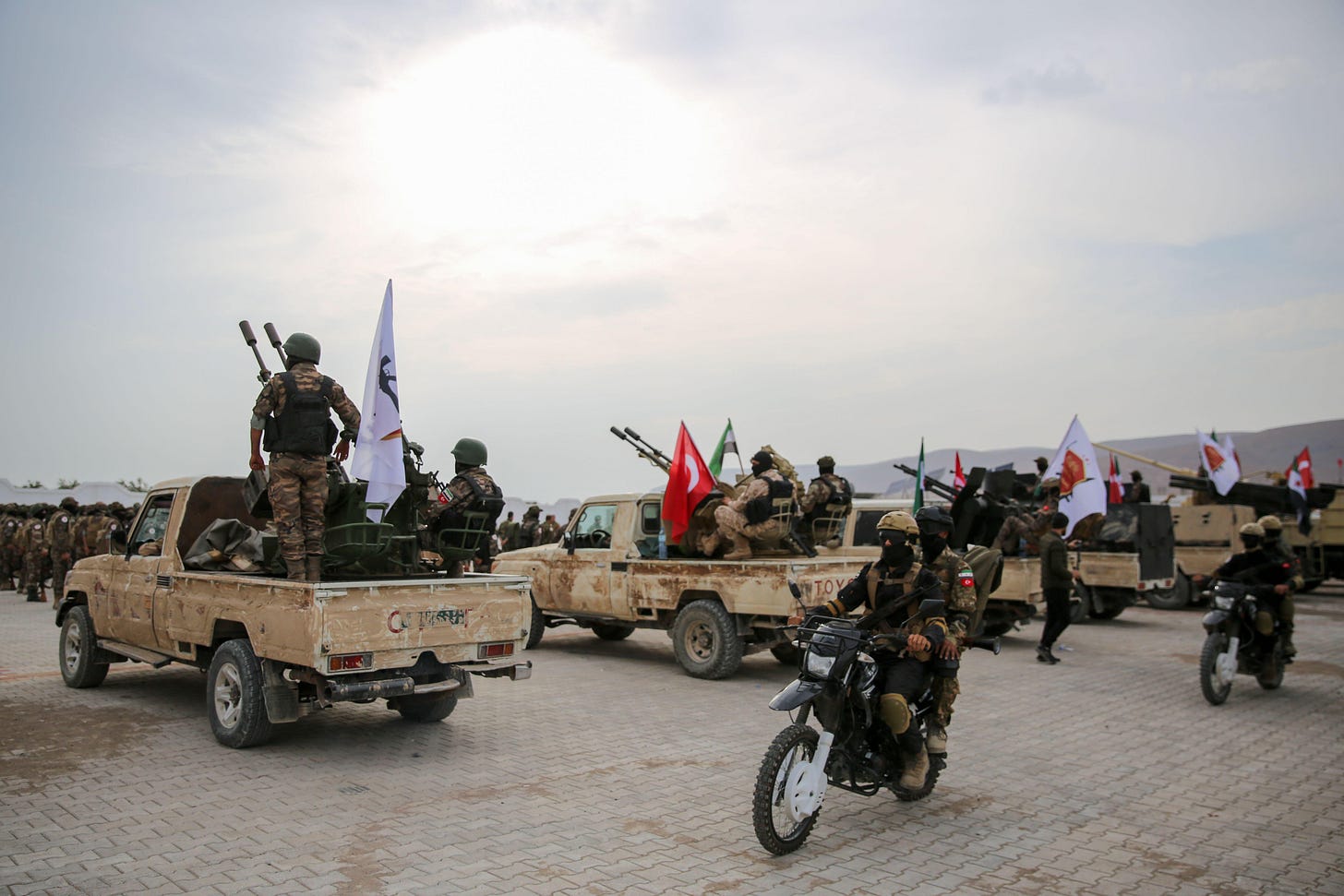'Thugs, bandits, and pirates'
Turkish-backed rebel factions in Syria have a sordid history of gangsterism. To the extent that they're not in control of the current rebellion, Syrians are probably better off for it.

The frozen conflict in northwest Syria is now unfrozen. After years of a front line enforced by Russian-Turkish agreements, several opposition groups have launched a lightening offensive against the government of Bashar al-Assad, and Hay’at Tahrir al-Sham (the “Levant Liberation Committee”) has successfully stormed Aleppo. The surprise offensive, called Operation Deterring Aggression, was supposedly a response to Assad’s sporadic terror bombing of civilians in rebel-held Idlib. The more obvious proximate cause was Assad’s patron Iran getting bogged down in Lebanon.
There’s a lot of controversy over whether HTS, a former affiliate of Al Qaeda that violently broke away, is “extremist.” (I recommend reading Dareen Khalifa and Aymenn J. Al-Tamimi, who has also been doing some excellent journalism on Operation Deterring Aggression, on the group’s recent history.) The problem with the Syrian National Army, the Turkish-backed rebel coalition in the area, is actually the opposite: They’re not ideological at all. From years of serving as Turkish mercenaries, these rebels have been reduced to behaving as “thugs, bandits, and pirates,” as a U.S. official briefed journalists in 2019.
By the way, one of the most infamous crimes by an HTS faction was the 2016 beheading of Abdullah Tayseer al-Issa, a 12 year old Palestinian boy accused of fighting in Assad’s army. The murder created political shockwaves not only because the victim was a child, but also because the faction involved — the Nour al-Din Zenki Movement — had received CIA support. A video of the beheading apparently drove President Donald Trump to cut CIA support for Syrian rebels. And what happened to the Zenki Movement? It split from HTS due to internal factionalism…and fled behind Turkish lines to dissolve into the SNA, just in time for the Turkish invasion of Kurdish territories.
During the Turkish invasion of Syria in October 2019, an SNA faction seized Kurdish Syrian politician Hevrin Khalaf from her car, tortured her, and executed her on the side of the road. The U.S. State Department refused to condemn the killing due to Trump administration politics.
My good friend Alexander McKeever has done some of the most in-depth research on Turkish-occupied, SNA-governed regions. Here’s a selection of journalism I’ve done on the same topic:
“The Olive Oil in Your Local Store May Be Funding Syrian Warlords,” The Daily Beast, 23 November 2020.
“Turkish troops present at Afrin torture sites, U.N. says,” Ahval News, 4 March 2021.
“US sanctions Syrian rebel group for crimes against Kurds,” Responsible Statecraft, 28 July 2021.
“US slap sanctions on formerly CIA-backed Syrian rebels,” Responsible Statecraft, 22 August 2023.
Although both HTS and the SNA are “authoritarian,” these are different kinds of authoritarianism. HTS runs a tight ship in Idlib, based on one-party rule and economic developmentalism. The SNA governs through organized crime and controlled chaos. For Syrians, it probably is a bit of a silver lining that HTS has the initiative within the opposition. It’s also probably not a coincidence, because HTS was much better poised to move quickly and independently in response to events on the ground.
The understandable focus on “jihadists” versus “moderate rebels” over the years has been a bit of a red herring. The “moderate rebels” are not some kind of nonexistent unicorn; they are a large part of the problem. To be a “moderate” in Washington’s eyes was to have no ideological vision for Syria, and to be willing to accept American aid with American strings attached. Although not every U.S.-backed rebel was a mercenary, the process definitely selected for mercenaries. Organized violence that doesn’t serve a political project and isn’t guided by values is just called gangsterism.
Take the example of SNA commander Sayf Bulad. A lot of hay has been made about the fact that he rubbed shoulders with both the CIA and the Islamic State. But that doesn’t mean that Bulad is a sleeper agent waiting to turn against his patrons to wage religious warfare. More likely, he’s the sort of person who’s willing to fight (and kill) for any patron who offers a good deal. He thrived in a war filled with fickle foreign patrons.
The two rebel factions that avoided this trap were HTS and the Kurdish-led Syrian Democratic Forces. Both are highly ideological — from opposite sides of the spectrum — and no foreign patron wanted to touch them in the beginning of the war. The SDF became Washington’s chosen partner because it was the only force organized enough to fight the Islamic State. Turkey was forced to accept HTS because it had ruthlessly crushed all other rebel factions in Idlib, including its former allies in Al Qaeda. No surprise, then, that these two forces now dominate Aleppo, while the SNA tries to nibble its way in from the outside. What happens next remains to be seen.


